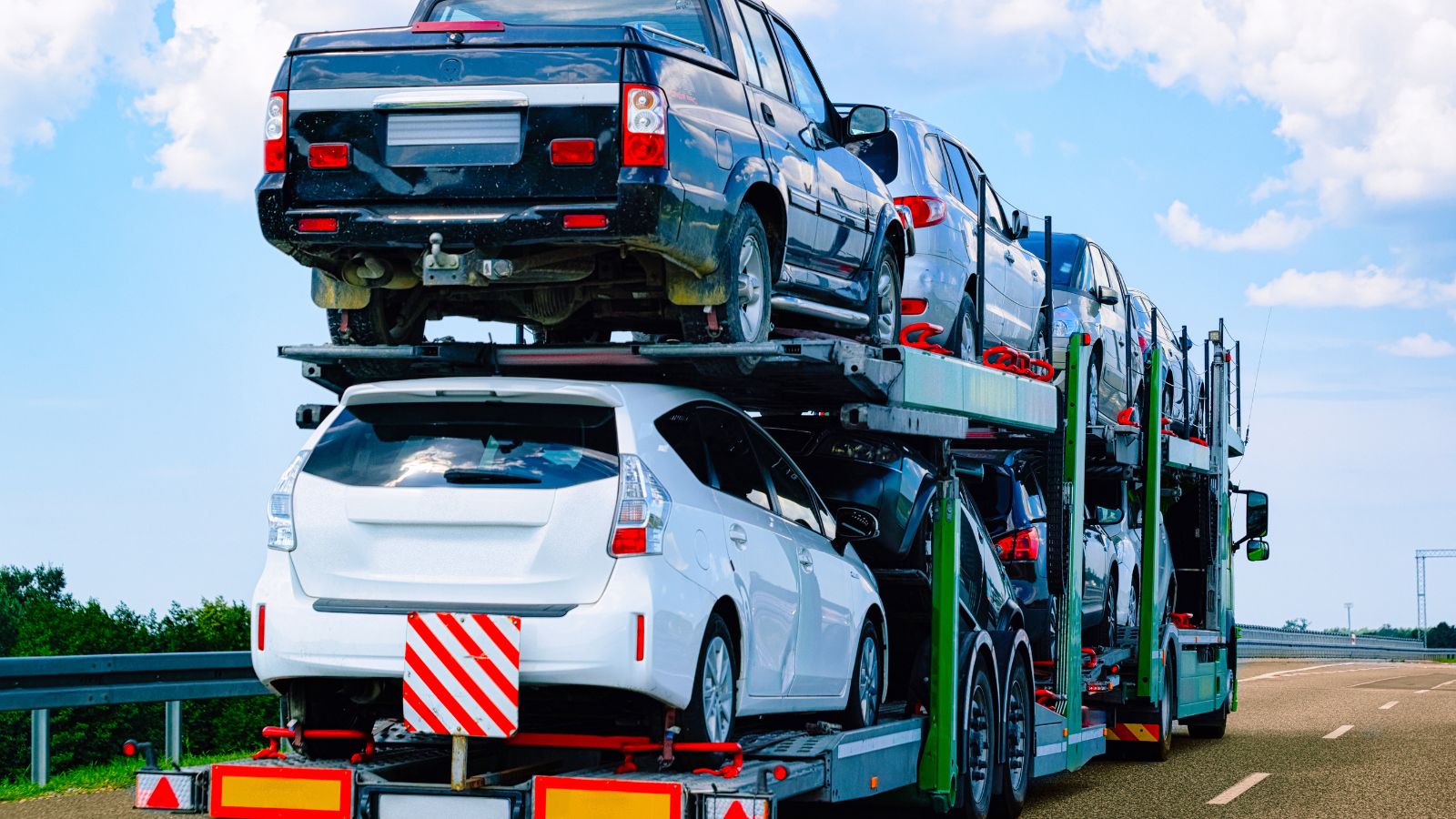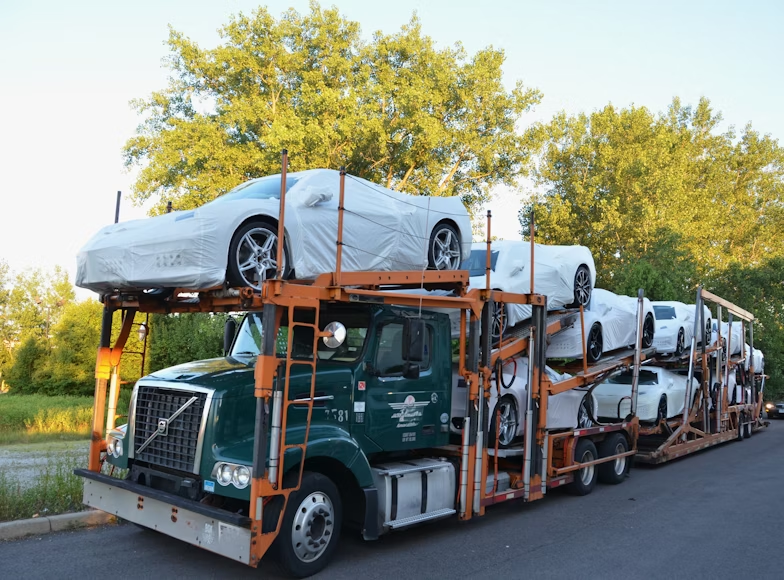Do you need to transport your car from one state to another but are unsure whether to choose open or enclosed transport?
You’re not alone. Tens of thousands of drivers each year struggle with the same decision when moving their car from one coast to the other. Or from one state to another.
Both options have advantages and disadvantages. But making the wrong decision could mean either paying too much for protection you don’t need or not paying enough to protect your expensive vehicle from damage.
In this article, we cover the main differences between the two transport options and how to make the best choice for your vehicle.
What you’ll learn:
- Open vs. Enclosed Transport: Key Differences
- Which is Less Expensive (And Why)
- When Enclosed Transport Makes Sense
- How to Choose the Right Option for Your Car
Open vs. Enclosed Transport: Key Differences
Open vs. enclosed transport — what’s the difference?
Open car transport is what you think it is — your vehicle is loaded onto an open trailer with other vehicles. These big car haulers travel the interstate hauling 8-10 vehicles at a time.
About 90% of cars are transported this way because it’s so affordable, fast, and has an excellent safety record.
Enclosed car transport, on the other hand, is the “premium” shipping method. Vehicles are loaded into a covered trailer with doors for easy loading and unloading. Enclosed trailers can be climate controlled for additional protection. Enclosed trailers carry less vehicles — usually between 2 and 6 depending on size.
Open vs. enclosed, which is best? The main thing people miss is that the differences are more than just “roof or no roof.”
There are additional key factors, like the level of service, insurance coverage, and even the driver that vary with each transport type.
For most car shipping needs, interstate car transport solutions offer both open and enclosed shipping. So you have options and can choose which makes the most sense for your vehicle and budget.
Which is Less Expensive (And Why)
What’s the biggest factor in deciding between open and enclosed car transport?
Cost, of course.
Open transport is much less expensive than enclosed. We’re talking hundreds of dollars cheaper for an open vs. enclosed cross country shipment.
Why is there such a price difference between open vs. enclosed shipping? It’s all about economics:
- Capacity. Open trailers can haul more cars (8-10 vs. 2-6), so the fixed costs are spread out over more customers
- Fuel efficiency. An open trailer is lighter and more aerodynamic than an enclosed one
- Availability. More open carriers on the road means more competition, which drives down the price
- Speed. Open carriers load/unload much faster than enclosed. These things all impact price.
For an average cross country move, enclosed car shipping costs around 50% more than open transport.
So if you get a price of $1,000 for open transport, it’s likely to be about $1,500 for enclosed transport.
But wait there’s more
Before you just choose the cheaper open transport method, there’s one more thing to consider.
When Enclosed Transport Makes Sense
 Opentransport isn’t always the best option.
Opentransport isn’t always the best option.
Enclosed transport is more expensive for a reason. It’s for when you really care about your vehicle getting damaged. Enclosed transport is more than just a cover for the road.
You should seriously consider enclosed shipping if:
- Your vehicle is valued at over $70,000. At this price, even minor road debris damage can be thousands of dollars to repair. Open vs. enclosed shipping cost is no longer “insurance” if your car could lose thousands of dollars of value in a transport accident.
- You have a classic, vintage, or collector car. These vehicles are rare and difficult to value. Preserving their original condition is key to their value. Sending your vintage car in an open trailer is like buying no insurance on a house fire.
- Your vehicle has sentimental value. Your late father’s restored Mustang or the dream car you’ve been searching for decades have worth beyond price tags.
Did you know…
Enclosed carriers tend to provide higher insurance coverage than open, and drivers are generally more experienced. Enclosed carriers tend to focus on the high-end transport market, so they specialize in protecting the valuable vehicles they carry. You’ll often find more white-glove service with enclosed transport than open.
The Hidden Benefits of Open Transport
Ok, here’s a secret…
Open transport isn’t just the cheap way to ship a car. It’s better than most people realize.
- Faster pickup and delivery. With more open carriers to choose from, your car can usually be picked up/delivered quicker.
- More route availability. Enclosed carriers don’t service less-popular routes as frequently as open carriers.
- Easy driver inspection. Open trailers can be easily inspected by drivers at stops without having to unlock the trailer.
- Solid safety record. Millions of vehicles are transported via open carriers each year. With safety stats like that, open transport has earned its reputation.
How to Choose the Right Option for Your Needs
Can’t decide which is best for your car? Then consider these three questions when making your decision:
- How much is your car worth? If it’s less than $30,000 and not a collectible, open transport is likely fine. If it’s between $30k and $70k, your risk tolerance is the deciding factor. If over $70k, then enclosed starts to make financial sense.
- How soon do you need your car delivered? If time is a factor, open transport is often faster.
- How much can you afford? Never choose a service you can’t reasonably afford, even if you “deserve” the more expensive enclosed transport.
But more than either of these questions, the best choice is always the carrier you pick.
Does the company have a great reputation and extensive experience in car transport?
Can they provide a current DOT number, insurance certificate, and valid business license?
These are the most important questions for choosing between open vs. enclosed car transport.
Making Your Final Decision
So, which is better? Open or enclosed car transport.
The best answer is: it depends.
Open car transport is more affordable, widely available, and statistically safe enough for most drivers’ needs.
So if cost and speed are your primary concern, open transport is hard to beat.
Enclosed transport is better for high-value, rare, or sentimental vehicles.
A little extra cost is worth the extra level of protection and service if your car falls into that category.
Here’s the most important thing to remember…
The right option is whichever service level you can afford AND feel most comfortable with. Don’t let anyone pressure you into an upgrade or downgrade based on price alone.
If you’re paying thousands for enclosed transport and an open would do just fine, you’re paying too much.
On the other hand, if you get in an accident and discover your carrier only offers minimum auto insurance, you’ll wish you had spent a little more.
Get several quotes, take the time to research and compare, and make the best decision for your car and your budget.
Wrapping It Up: Open vs. Enclosed Transport
The good news about choosing between open and enclosed car transport is that either one works great for their intended purpose.
Open transport is better for:
- Standard vehicles under $30k in value
- Drivers who prioritize speed and cost savings
Enclosed transport is better for:
- Vehicles over $70k in value
- Classic, vintage, or collector cars
- Vehicles with sentimental value to you
The car shipping industry provides both options for a reason — each has its place, and different cars need different solutions.
Take the time to weigh your options and make the right decision for your vehicle. Get quotes from multiple companies and decide which gives you the best combination of value and service for your car.
Whichever option you choose, make sure it’s the right decision for your car and your budget, and the move should go smoothly.
Your vehicle’s journey from point A to point B shouldn’t be filled with stress.

